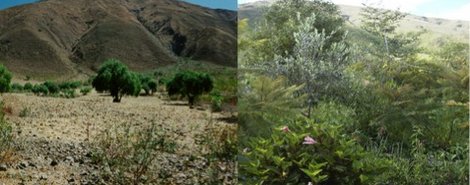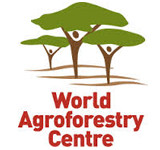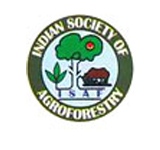
Vigyan Bhavan & Kempinski Ambience
10 - 14 February 2014
Delhi, India
blog

Degraded land before and after the implementation of dynamic agroforestry systems
Soil recovering and organic production in a semi-arid valley of Bolivia through “high diversity dynamic agroforestry”
Summary: There is broad scene of agroforestry ranging from “alley cropping” up to building a natural forest system providing products for humankind. After 13 years testing different agroforestry approaches in the challenging semiarid area of the Bolivian Andes the “high diversity dynamic agroforestry” seems to be the most effective method. Copying the natural processes as best as possible and creating a “high diversity dynamic agroforestry system” provides rich soil, stable yields with variety of products while pesticides or fertilizer nor watering is needed. It is an agro system which grows and changes dynamically thus requesting a new approach and perspective of us producers. Still, once learned and accepted the principles of “dynamic agroforestry” it opens to the producers a new world creating productive spaces without the well-known problems of conventional agriculture. Instead of soil degradation, water shortage and dissemination of harmful insects and plant diseases, “dynamic agroforestry systems” have advantages in biophysical and socioeconomically aspects, show resilience of productivity and a very high capacity to sequester carbon. Thus counters global warming and offers to realize climate smart agriculture.
The following describes the process and main discoveries of “high diversity dynamic agroforestry” in Mollesnejta, Bolivia.
On-site situation in 2001: Degraded, stony soil, erosion and absence of vegetation are the consequences of grazing pressure on a hillslope in the Andean valley of Cochabamba/Bolivia. This property named Mollesnejta is situated at 2.800 Meter above sea level, were average precipitation is 450 mm/year with up to nine months of dry season.
Undertaking: planting native and exotic trees and bushes, combining nitrogen fixing species with fruits and nuts, in between crop plants, vegetables and spice plants. Natural regeneration is allowed in order to create a holistic production system. This imitates ecological dynamics of a forest ecosystem as well as the typical climax vegetation (the species which establishes itself in the absence of disturbance on a given site for given climatic conditions and soil properties). There was much drawback in the beginning because of cows intruding from neighborhood areas and devouring the young plants, ants cutting leaves causing death of the little trees and others. We learned to manage our agroforestry systems successfully by observing nature. We copy the principles of diversity, density and natural succession until achieving a quasi-natural production system with structural and functional aspects of indigenous forests and natural dynamics.
Methods:
- Plantation of a large diversity of fruits, nuts, vegetables, spice and crop species in combination with a huge diversity of native species in the same space
- Association of perennial fruit species and native plants, giving preference to those which fix nitrogen and / or act like natural repellents
- Combination of species with a different status in the natural succession (pioneer, secondary, primary)
- Optimizing space use by producing in all strata (belowground and at different levels aboveground like in natural forests)
- Planting of sensitive fruit species in the shelter of native bushes and trees
- Maintenance of the plant community in a developing process (sub-climax status) trough periodic tree-pruning with the aim to stimulate the sprouting
- Protection of the soil using the organic material from tree-pruning as mulch
Results in productivity & soil enrichment:
The diversity of species stabilizes the production system
- The density of plants protects the soil against erosion, extreme changes of temperature and dehydration
- Native species in the production system induce to a natural balance between non-beneficial and beneficial organism, rendering unnecessary the use of pesticide
- The decrease of evaporation trough mulching of the soil and the plantation of living fences against hot and dry wind
- Fertilization of the soil through the decomposing of foliage, organic matter from tree-pruning and dead rootage
- Improvement of structure, drainage and respiration of the soil through increased rootage
- Improvement of rainwater infiltration into the soil and its capacity of water retention
- Optimization of the soil structure and preservation of fertility through the elaboration and application of agricarbon made from pruning material
- Interaction of different plant species results in synergy of development with high production
Outcome: after 13 years of work with “high diversity dynamic agroforestry” the soil has a considerable percentage of humus content and all plants show a good state of health. Although there is the presence of some pest insects, they cannot spread because of an antagonist fauna. The clou to manage the system consists in the periodical pruning of trees and brushes to preserve its productivity through maintaining the status of development or subclimax. All organic material from cutting is spread on the soil (mulching). The mulch layer converts into humus restoring the soil fertility trough the inhibition of nutrient and soil runoff, cycle of nutrients and capacity of humidity retention.
Result: “high diversity dynamic agroforestry systems” offer commodity benefits as well as non-commodity benefits (adaptation to climate change, mitigation of climate change, ecosystem services, habitat for endangered species, landscape molding). The production process demonstrates resilience to external influences (weeds, diseases, insect pests, extremes of temperature) and diversity of crop minimizes the risks of market failure.
On-site situation in 2014: On the 16 hectares of the Mollesnejta property we focused on soil restoration beginning with pioneer and sun-loving species. This prepared the ground for more delicate species which developed into a more mature system that is detained in a sub-climax state to preserve productivity. Today we are experimenting on a restored soil with 32 different types of “dynamic agroforestry systems”, producing organic fruits, olives, berries, vegetables, spices, herbal medicine, honey, crop plants and forage, furthermore firewood and wood for construction and the production of agricarbon.
The network Espacio COmpartido en Sistemas AgroForestales (ECOSAF) is promoting “good practices” and “lessons learned” obtained in Mollesnejta (www.ecosaf.org).
Photo:
Left: Degraded land in 2001 before the implementation of dynamic agroforestry systems.
Right: The same view in 2007 with dynamic agroforestry systems.
Blogpost and photo by Noemi Stadler-Kaulich (Farmer in Combuyo, Cochabamba/Bolivia) – nstadlerkaulich(at)googlemail.com
|
This post is entry nr #24 in our #WCA2014 blog competition. The five blogposts with the most and highest votes will receive a signed copy of the book “Trees for Life”. The most popular blogpost will get an iPad.
This blogpost received 18 votes, with an average score of 5 (out of a max of 5). If you have questions or remarks on the project described in this post, please leave a comment below. Please also rate the other blogcompetition entries! Follow our #WCA2014 social reporting teamfollow our social reporting team via the #WCA2014 tag on Twitter, our blog and our Facebook page.
|






4 People have left comments on this post
IT IS INDEED A VERY COMPREHENSIVE COVERAGE OF THE MEASURES FOR REVIVING THE SOIL QUALITY TO ITS PRIME HEALTH . I WISH THIS FORUM PREPARES SCIENTIFIC GUIDE LINES , IN SIMPLE LANGUAGES FOR THE SKILL DEVELOPMENT OF ALL SORTS OF ENVIRONMENTALISTS, ACTIVE ALL OVER THE WORLD, MANY OF THEM HALF BAKED DUE TO IGNORANCE OF THE CORRECT INPUTS .
i WISH THEMA VERY FRUITFUL SUCCESS
Good approach! And good idea of a scientific guide lines or even scientific research about the methods and results of the “high diversity dynamic agroforestry”.
Very good!! I liked this article.
Only agroforestry prevails